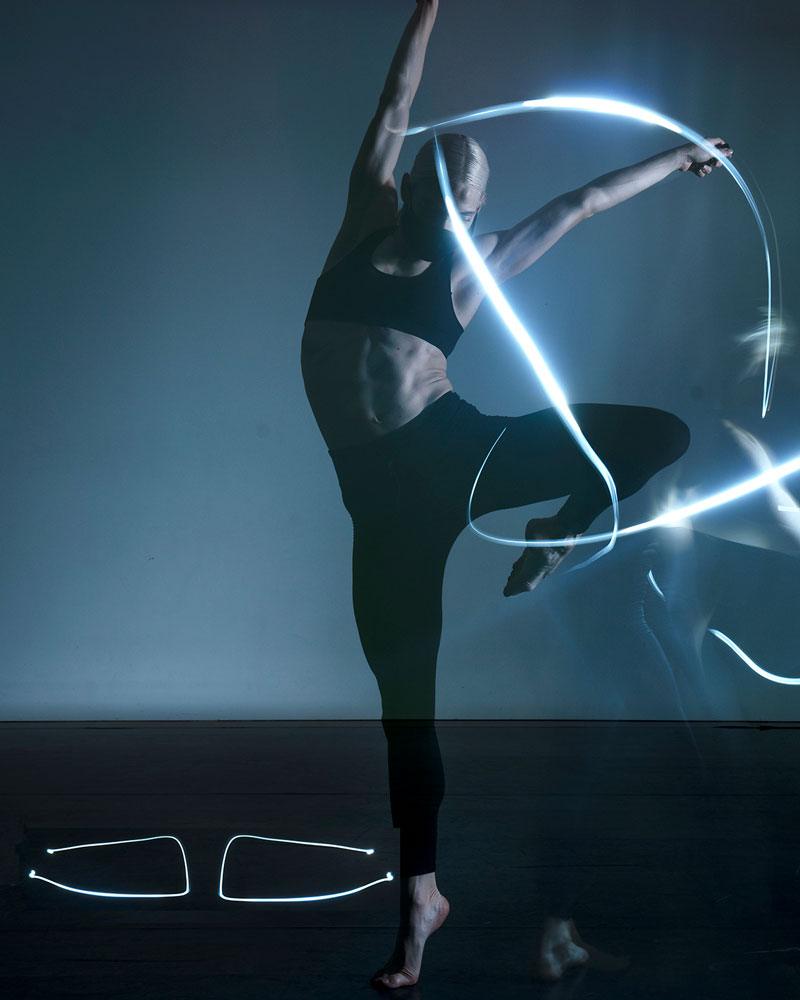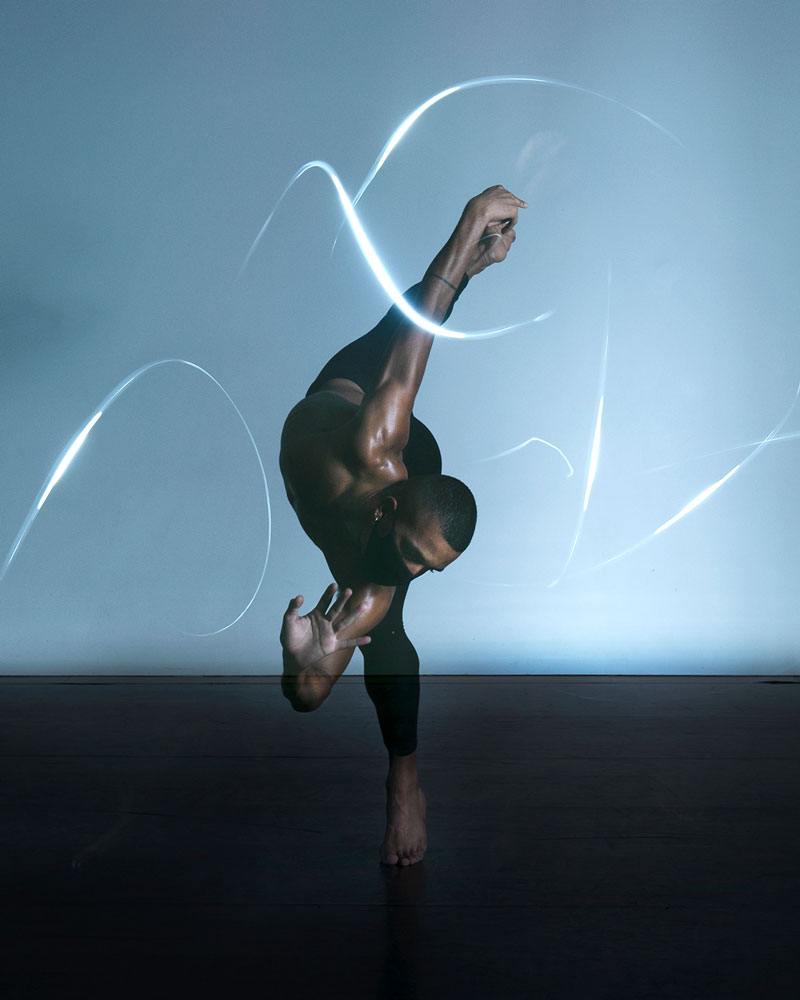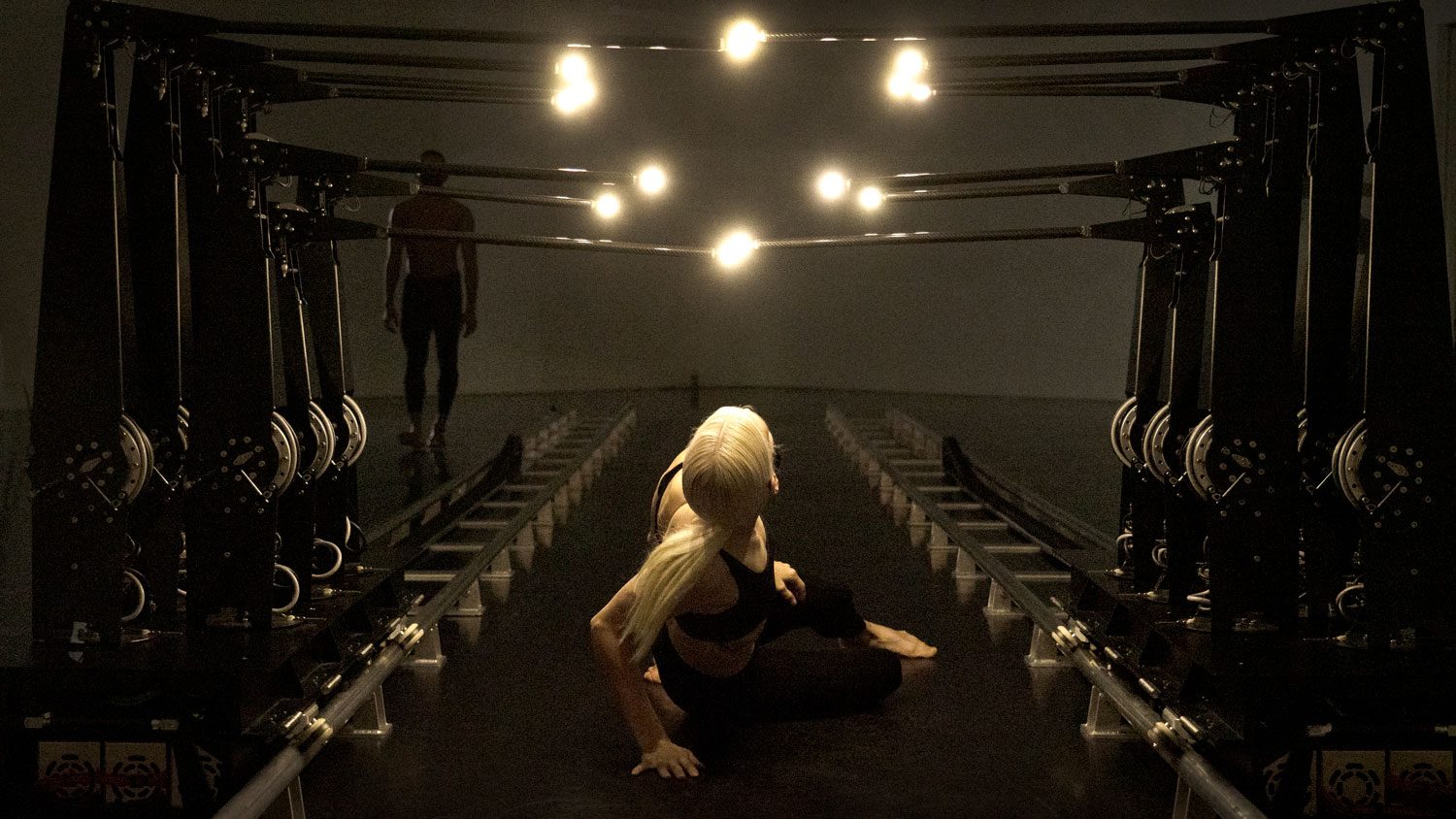Elegant yet eerie. Choreographed yet spontaneous. Futurist yet primitive. At the core of Random International’s oeuvre are dichotomies that at once ground and challenge the viewer. While the collective’s German founders, Hannes Koch and Flo Ortkrass, are perhaps best known for 2012’s Rain Room, they have been producing surreal works around the world since 2005. For example, their 2019 Kinds of Life at London’s Great Ormond Street Hospital saw a suspended, glistening red orb gracefully follow and respond to passersby, while the 2008 Audience featured a horde of mini mirrors on robotic feet tilting and turning in synchronized gestures to face visitors.

A detail shot of the light points on the robotic sculpture. Photo: Courtesy BMW, Random International, Studio Wayne McGregor, and Superblue

No One is an Island presented by Random International, BMW i, Studio Wayne McGregor, and Superblue. Photo: Courtesy BMW, Random International, Studio Wayne McGregor, and Superblue
Commissioned by Studio Wayne McGregor, the latter work (Random International’s first kinetic piece), served as the launching point for the collective’s newest project, No One is an Island presented by BMW i and Superblue—for which the avant-garde choreographer and director has returned. Premiering virtually from November 25 in three chapters (each focusing on either sculpture, dancers or BMW) the piece is in keeping with Koch’s and Ortkrass’s ongoing exploration of interaction between man and machine. Scored by Japanese electronic music artist Chihei Hatakeyama, the performance features two dancers engaging with 15 monumental robotic arms, each containing a light source, that move into both abstract and figurative formations.
The idea stems from the studies of a German cognitive scientist who determined that 15 light points arranged along the human body are the minimum amount of visual information necessary for the human brain to register movement as natural or biological. “Even without a head, face, arms, legs, or all these features you think would be necessary, seeing these light points in movement, you immediately knew they represent a human,” Koch tells Galerie on how McGregor initially sparked his and Ortkrass’s curiosity for kinesthetic and cognitive knowledge. “When you start manipulating the way the light points move, you can derive enormous amounts of secondary information such as gender, body weight, and emotional state. We wondered, could these two-dimensional flash animations be translated into real sculpture?”

An image of a dancer mid-performance is captured via long-exposure photography, Random International’s way of drawing with light. Photo: Courtesy BMW, Random International, Studio Wayne McGregor, and Superblue
After multiple attempts to perfect their robotic sculpture’s precise movements, BMW Group Culture and BMW i (the company’s electric-vehicle division) teamed up with Random International to perfect the work’s manufacturing, engineering, and scaling. According to Koch, their partnership has revealed deep synergies between both the brand and the collective. “There’s a real dedication to quality, skill, material, and workmanship,” he says, adding that another key similarity is the commitment to reduction and sustainability in the electrical car industry. “With the i3, BMW has done a big exercise in reduction. That’s something where we meet from a cultural perspective. They’re very keen for us to have an authentic exploration of these topics, and that’s quite a lot to ask for as an artist.”

Photo: Courtesy BMW, Random International, Studio Wayne McGregor, and Superblue
As for the storytelling behind the sculpture, Random International wanted the robotic arms’ light points to alter between being spread at random versus clearly forming a human in motion. One moment you feel you are watching a person; the next you are disoriented from the familiar silhouette dispersing into thin air. Ortkrass describes the emotional goal as tapping into a person’s “empathy with machines,” as well as society’s superiority of the human connection over one based on artificial intelligence.
“There’s a lot of studies about how you make a robot dog walk, but very few studies discuss what that does to you when you see it,”
Flo Ortkrass
“When our brains formed there was nothing that was a robot, so we never learned to distinguish between something that is alive and something that pretends to be alive. Now we’re at a funny point when we can make machines that exhibit behavior that is very, very close or nearly indistinguishable from biological movements or reactions,” Ortkrass explains. “There’s a lot of studies about how you make a robot dog walk, but very few studies discuss what that does to you when you see it.”

A still image of one of the dancers showcases the long-exposure photography Random International hopes to use when No One is an Island debuts in person. Photo: Courtesy BMW, Random International, Studio Wayne McGregor, and Superblue

A dancer in motion. Photo: Courtesy BMW, Random International, Studio Wayne McGregor, and Superblue
That human response to the ambiguity of anthropomorphic behavior is what drives Ortkrass, Koch, and McGregor whose dancers’ movements mimic a complex grappling with the robotic sculpture. “No One is an Island has become increasingly about what happens if we feel for and with machines,” adds Koch, who also raises questions about machines and companionship. “There have been studies where lonely elderly folks speak with robots, and in some instances, pour their hearts out. Does it matter if your counterpart actually understands and empathizes? Is the simulation enough?”
Eventually Random International plans to debut this project in person so visitors can interact with it and see themselves on a large video projector with the space around them augmented. Long-exposure photography will capture their unique movements via the light points’ response to them—a technique already brilliantly captured in the existing No One is an Island performance photography. “Drawing with light is something incredibly democratic because it’s an ephemeral medium,” Koch explains. “If you feel you’re inadequate as a sculptor, a light drawing fades out, and you can try it again. If it’s offered in the right way, it really lowers inhibitions to express yourself.”

No One is an Island presented by Random International, BMW i, Studio Wayne McGregor, and Superblue. Photo: Courtesy BMW, Random International, Studio Wayne McGregor, and Superblue
No One is an Island will be shown exclusively on the digital channels of all participating partners in November through January 2021. The premiere is split in three chapters, each focusing on either sculpture, dancers or BMW i. All of them will be shared on Instagram and Facebook by Random International @randominternational, Studio Wayne McGregor @studiowaynemcgregor, Superblue @superblue.art and BMW @bmw, @bmwi, and @bmwgroupculture.
Register here to be among the first notified about the live performance in 2021.







